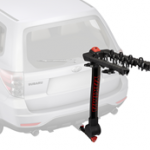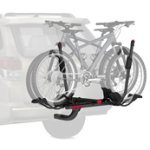Buying a bike rack is an important decision, especially since there are several types available and the price can vary depending on the model. So before rushing into a purchase, ask yourself the following questions. This will help us recommend the type of rack that best suits your needs and your budget:
5 Questions to Ask Yourself:
- What type of vehicle will you be installing the bike rack on? Does it already have a trailer hitch and/or a roof rack?
- How many bikes do you plan to transport? What type of bikes?
- How often will you use the bike rack? Several times a summer or just 2 or 3 times?
- Do you plan to leave the bike rack on the vehicle or store it after each use? Do you need access to the rear trunk?
- Are you thinking of carrying other gear (skis, kayaks, luggage, etc.)?
3 Categories of Bike Racks
There are three main categories of bike racks. Each comes with its own pros and cons.

HITCH-MOUNTED BIKE RACK – TILTING TYPE
This type of bike rack is recommended for those who plan to transport their bikes multiple times throughout the summer.
These racks are sturdy and attach to 1.25” or 2” trailer hitches. They’re ideal for cyclists who regularly need to carry bikes. Plus, they’re compatible with most types of bikes—road, mountain, hybrid, and children’s bikes. If your bike has a sloping top tube, you may need an adapter.
Tilting hitch-mounted racks are a great option if you still want access to your trunk. Most manufacturers—including Thule, SportRack, and Rhino-Rack—offer models with this feature.
Tilting hitch racks are especially suitable for families with multiple bikes or for cyclists who use their rack often. They work best with road bikes or bikes that have a relatively straight top tube.
Cradle-Style Hitch-Mounted Bike Racks
Unlike tilting hitch racks, which hold bikes by the top tube, cradle-style hitch racks secure the bikes by the wheels or frame. This allows for the transport of a wide range of bike frame styles and sizes, with less risk of damage—an important factor for preserving your paint job!
All cradle-style hitch racks lock in place using a hitch pin, as seen in models by Yakima, Thule, SportRack, and Swagman. This means you can safely secure your bikes—and also lock the rack itself to your vehicle.

Trunk-Mounted Bike Racks
Trunk-mounted bike racks are a lightweight solution for day trips. They attach to most cars using straps that hook onto the rear trunk. With a bit of practice, they’re fairly easy to install. However, they’re meant for temporary use only, as they don’t have a locking system and can’t be left on the vehicle permanently. Additionally, trunk access is usually blocked when the rack is in place.
That said, they’re perfect for occasional cyclists or for those whose vehicles don’t have a trailer hitch.
Trunk-mounted bike racks offer an affordable option for casual bike transport. They’re also ideal for cyclists whose vehicles lack a hitch or crossbars.

Roof-Mounted Bike Racks
There are many benefits to transporting bikes on the roof of your car rather than on the back. We recommend watching Yakima’s video that compares hitch-mounted racks to roof-mounted options. Ultimately, the choice depends on your vehicle and personal preferences. ” target=”blank”>Yakima’s online fit guide will help you select the right rack based on your vehicle—whether you’re using existing rails or need to install new rails and crossbars.
Beyond carrying bikes, roof racks can also hold gear for water sports or winter sports, as well as cargo boxes for extra storage.
For adventurous families, a roof rack is an essential accessory—it allows them to carry bikes, canoes, skis, and a wide variety of gear. However, it may not be the best option if you frequently use underground parking!
Depending on your vehicle type, several other options are also available, including racks that mount to the platform or spare tire. To explore these alternatives, visit the Yakima website and be sure to check out their online “Fit My Car” guide.

